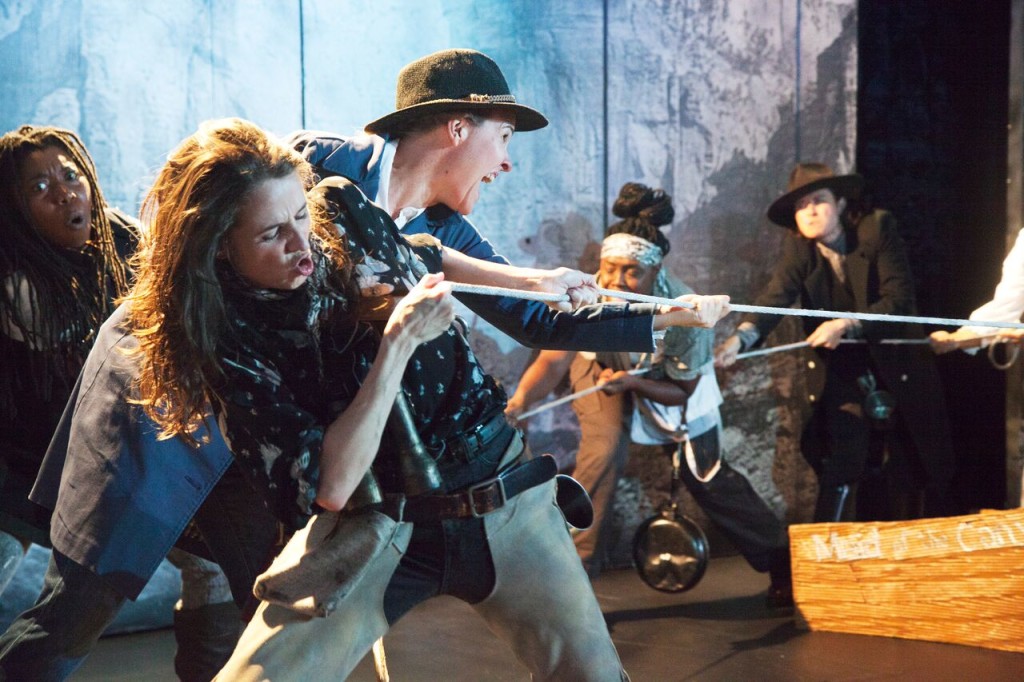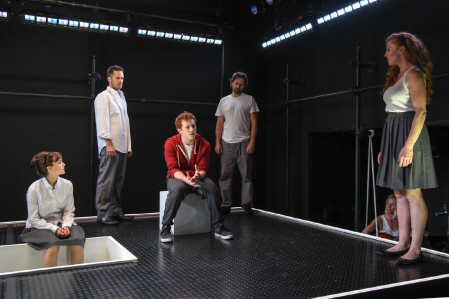by Michael Bracken
It takes a special kind of man to boldly go where no man has gone before. And the men in Men on Boats at Playwrights Horizons are nothing if not special. For starters, they’re not men: all ten cast members of Jaclyn Backhaus’s tongue-in-cheek comedy are females playing males. They’re re-creating the 1869 expedition led by John Wesley Powell, charting the course of the Colorado River as it approaches and winds its way through the Grand Canyon.
Come to think of it, they don’t go anywhere no man’s gone before either. The Indians had no doubt been going through the canyon for centuries, and Civil War deserters traversed the same turf. There was even another expedition that covered at least part of the same route, but it wasn’t government sanctioned like Powell’s. And, as Powell tells his men, “a government sanctioned frontier is much different than uncharted land.”
Director Will Davis helms the onstage foray into the unknown with a steady yet agile hand. It’s no surprise he’s also a choreographer, since the movement in Men on Boats is meticulously orchestrated. Movement is a key element of the adventure’s enactment and plays a large part in its left-handed appeal. Often the game cast shifts position as a unit to accommodate the surging current. They lean left or right as dictated by the mighty river, Major Powell, or their fellow explorers. When three of the men get sucked into a whirlpool, they convincingly (within the play’s skewered reality) run around in a circle to convey their plight.
Davis has assembled a top-notch design team, with expert lighting by Solomon Weisbard. Arnulfo Maldonado’s set is a huge photo of the Grand Canyon, which takes up all of the back and side walls of the stage. The back wall, we soon learn, has doors in it, through which actors enter and exit. Later we see at least two of the doors come off their hinges, allowing even easier access on and off the stage. The overall effect complements the mood Backhaus and Davis create, deflated history with a whiff of naturalism and a heavy helping of whimsy.
The exploratory party consists of four boats – down to three by journey’s end – indicated by bottomless bows of rowboats, perhaps a quarter of the size of the would-be boats, which the actors mostly carry at waist height. Sound designer Jane Shaw brings the great outdoors, especially the roar of the raging river, to Forty Second Street. Simple period outdoorsman costumes by Ásta Bennie Hostetter enhance the gender posturing of this band of pioneers.
The cast is up for a good time and delivers one to the audience. Performances are italicized but only slightly; no one goes overboard (unless the turbulent current takes them there). Birgit Huppuch as Goodman is especially funny with an officious British accent and a distaste for discomfort. Hannah Cabell and Danaya Esperanza play the Howland brothers and double as a deadpan Native American couple. The Indians agree to help Goodman when he leaves the expedition, in what is probably the play’s funniest scene.
Kelly McAndrew is all measured authority as Powell, and Elizabeth Kenny is an imposing figure who doesn’t say much, as his brother, Old Shady. Dunn, quick to challenge Powell’s decisions, is a restrained egotist in a Russian hat as played by Kristen Sieh.
But it’s the ensemble that stands out, more than any one performer. For all their characters’ idiosyncrasies, performances resonate in the same key. Dressed like men and sounding (mostly) like John Wayne in a higher octave, they are definitely sending up the heroic male archetype. But no disrespect appears to be intended.
Through Sunday, August 14, 2016, at Playwrights Horizons’ Peter Jay Sharp Theater
(416 West 42nd Street). www.TicketCentral.com and www.Facebook.com.
90 minutes, no intermission.
Photos: Elke Young

























